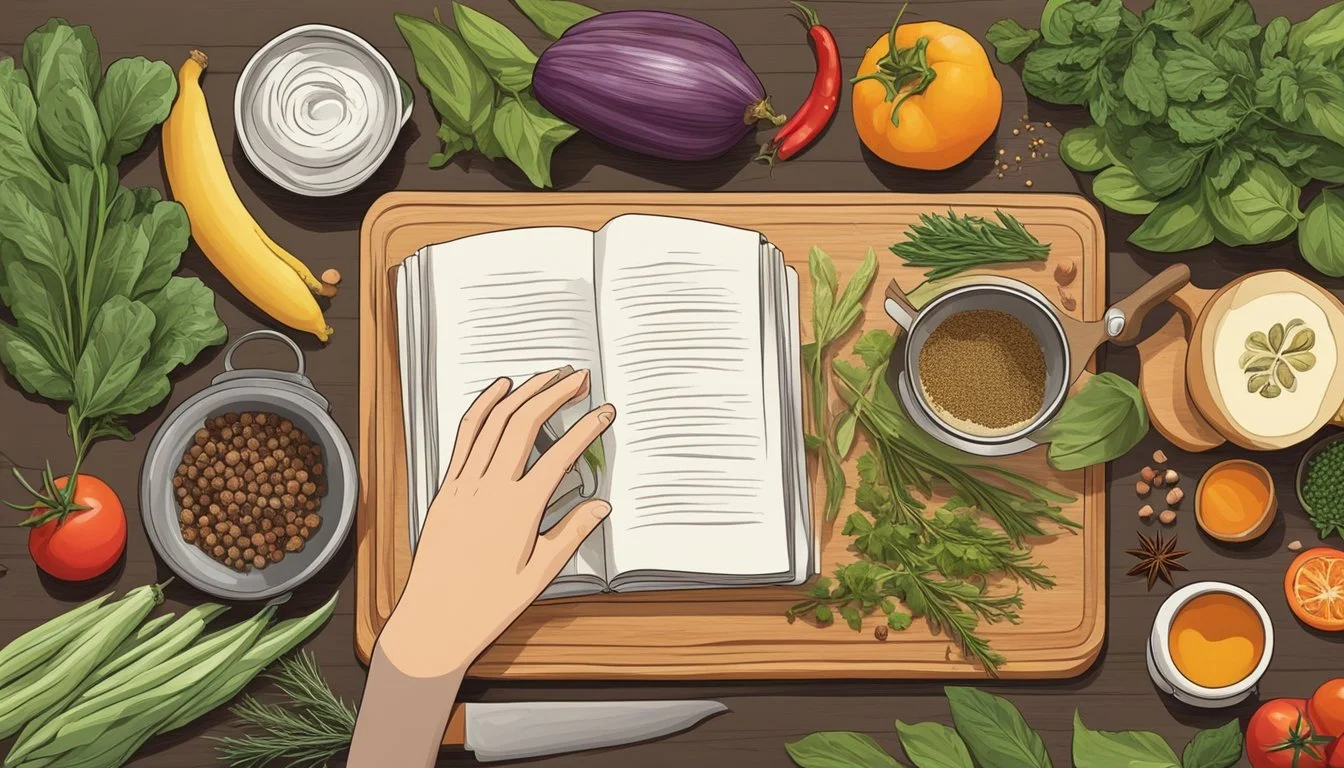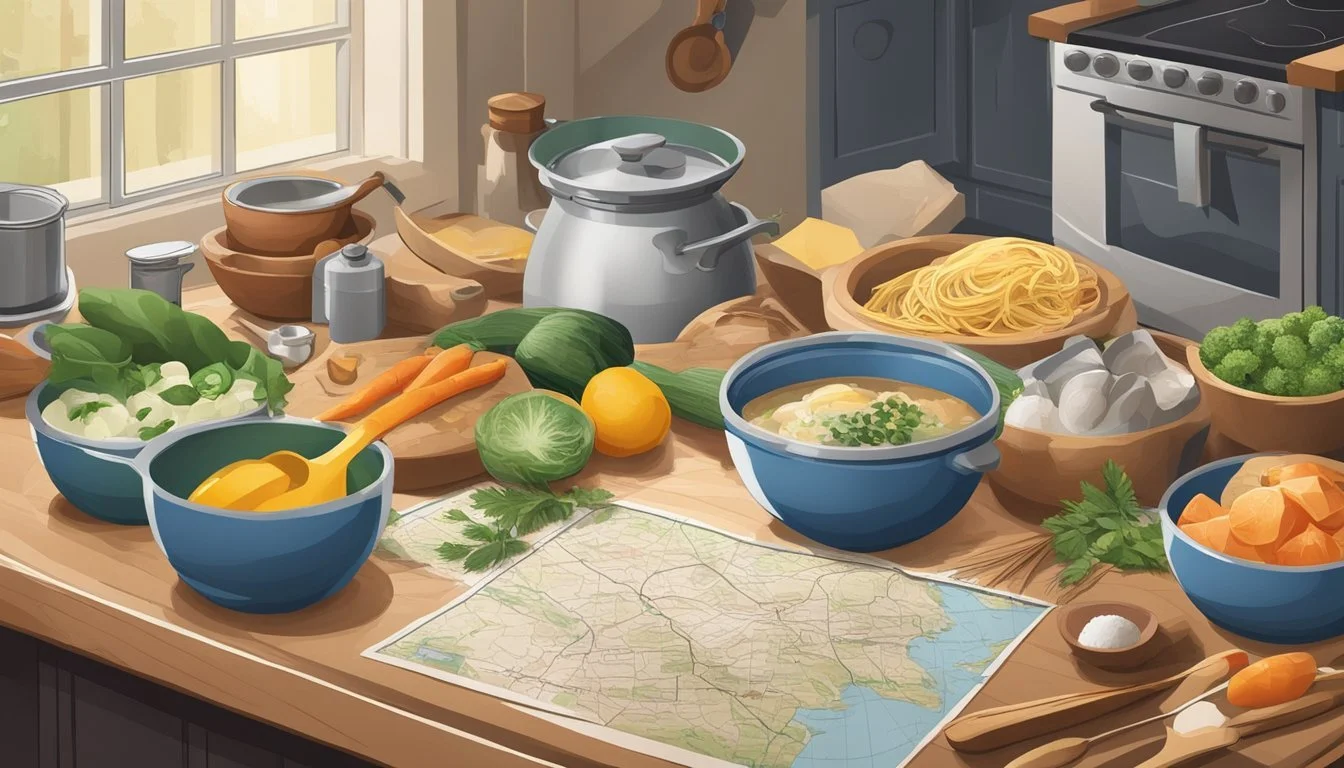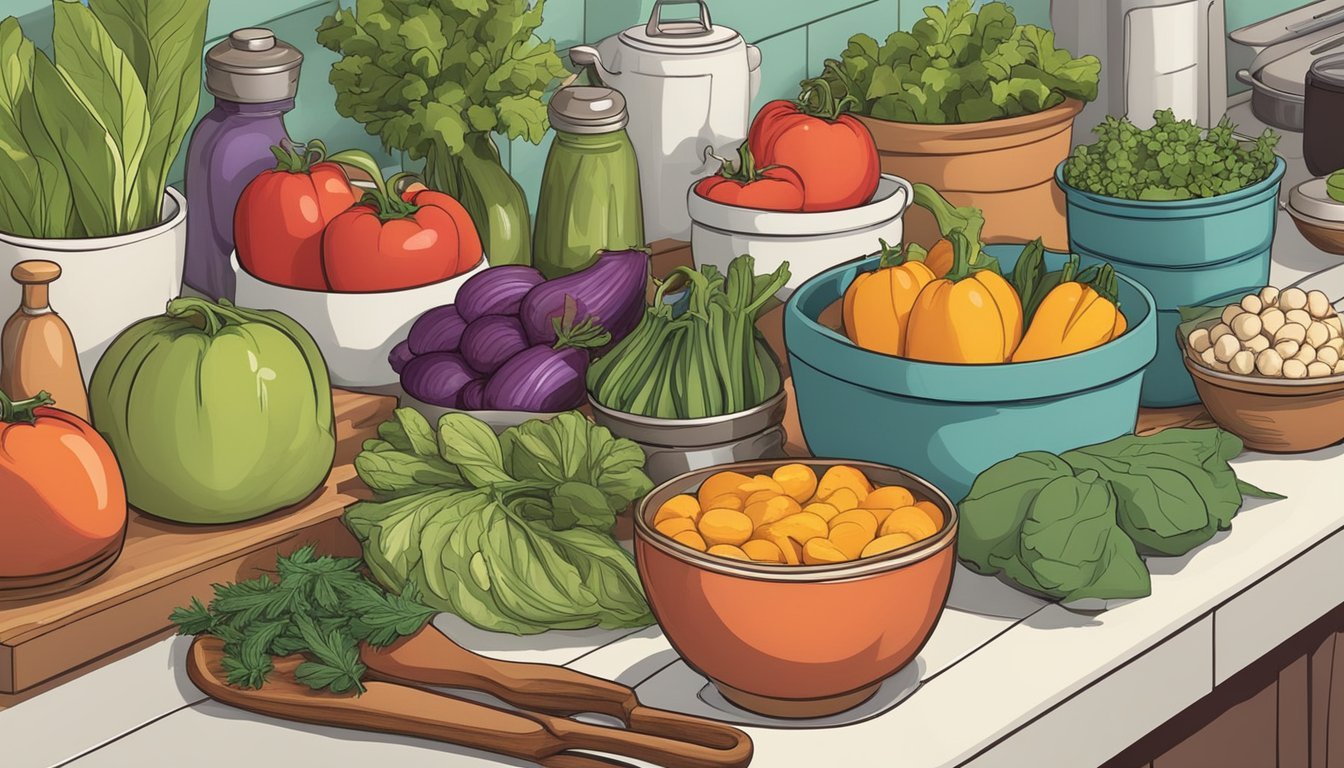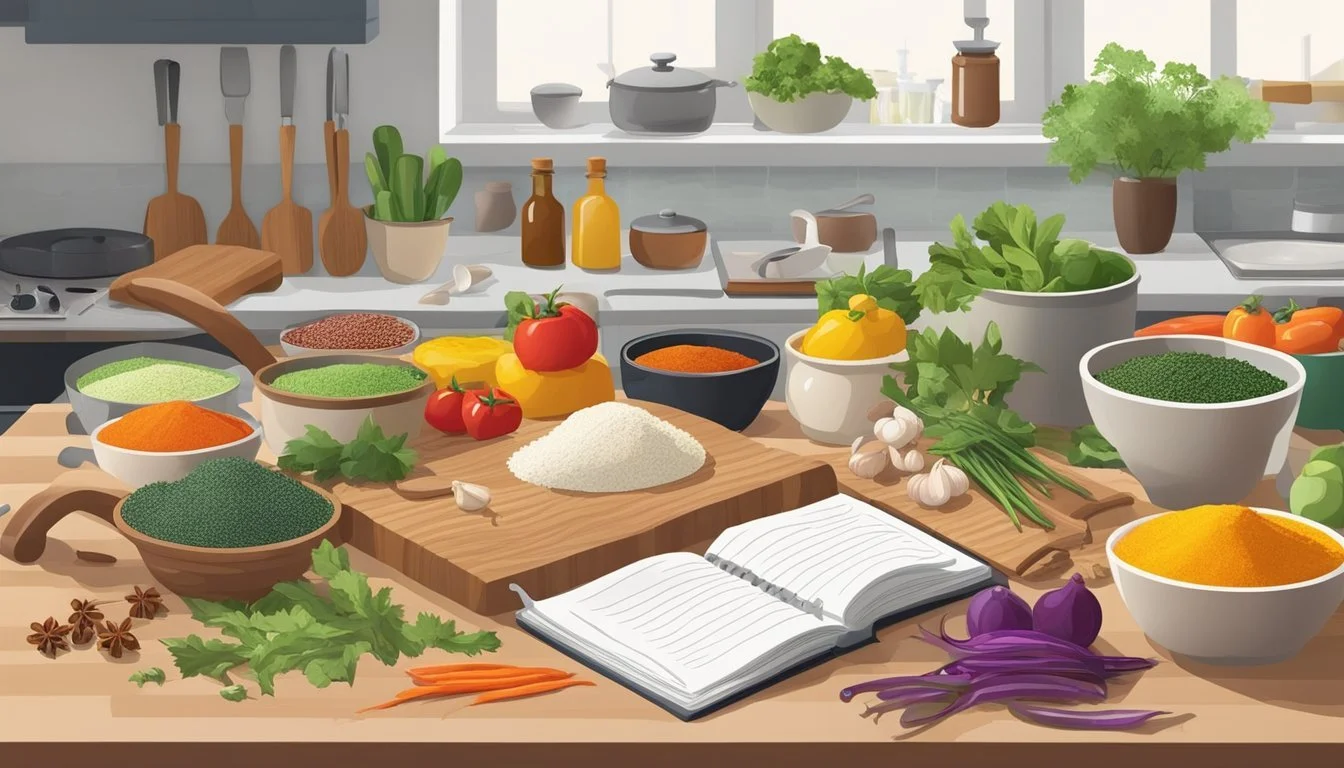How to Cook When You're Embarking on a Culinary Tour at Home
Mastering Diverse Cuisine Essentials
Embarking on a culinary tour at home offers an enriching experience that brings the essence of global gastronomy into your kitchen. This form of culinary adventure allows individuals to explore and appreciate diverse cultures through their rich and varied cuisines. By cooking dishes from different parts of the world, you not only satiate your taste buds but also expand your cooking skills and culinary understanding. With each recipe, home cooks can traverse international boundaries and delve into the heart of a region's culinary traditions, creating a bridge between their home and distant lands through flavors and techniques.
The process of preparing and enjoying dishes from various cultural backgrounds can be as enlightening as it is delightful. To recreate authentic dishes at home, it's important to focus on using fresh, locally-sourced ingredients whenever possible, replicating the practice of visiting local markets like on traditional culinary tours. Incorporating genuine ingredients contributes to the authenticity of the gastronomic adventure, allowing a more truthful representation of the original cuisine.
A successful at-home culinary tour is not just about the preparation of meals; it also includes understanding the cultural significance and the traditional methods that define the cooking style of each cuisine. Home chefs are encouraged to research the origins of the dishes they are preparing, using this knowledge to inform their cooking technique and presentation. This educational element turns the act of cooking into a holistic journey—a celebration of the world’s culinary diversity right from the comfort of one's own kitchen.
Setting the Stage for Your Culinary Tour
Embarking on a culinary tour at home involves immersing oneself in global cuisine, preparing with quality ingredients, and understanding the historical and cultural significance of distinct culinary traditions. Here is how one can prepare the kitchen and oneself for the journey into the diverse flavors of the world's culinary destinations.
Understanding Culinary Tourism
Culinary tourism is the pursuit of unique and memorable eating and drinking experiences, often by traveling to a culinary destination. At home, it offers the chance to explore global cuisine through the act of cooking, uncovering the history and cultural significance behind each dish. One can begin by researching the origins and culinary traditions of the chosen cuisine, noting how these practices have shaped the food being prepared.
Embracing Global Cuisine at Home
Ingredients: Start by curating a list of region-specific ingredients that are staples in the chosen global cuisine. This might include spices, grains, proteins, and produce that are authentic to the culinary tradition one is exploring.
Recipes: Select dishes that represent a spectrum of the region's culinary portfolio to appreciate the breadth of the culture's gastronomic offering.
Cultural Significance: Consider the historical context and cultural stories behind each recipe, as it will deepen the understanding and appreciation while cooking.
Preparing Your Kitchen for the Journey
To create an authentic culinary tour at home, one's kitchen should be equipped to handle various cooking techniques and ingredients characteristic of the chosen global cuisine. This preparation could include:
Utensils and Cookware: Investing in the right tools, such as a wok for Asian cuisine or a mortar and pestle for crushing fresh spices, can enhance the authenticity of the cooking experience.
Organization: Arranging ingredients and cookware for efficient access mirrors the readiness found in professional kitchens and allows for a smooth cooking experience.
Cleanliness: Ensuring the kitchen is clean and well-maintained prevents cross-contamination and honors the culinary traditions being practiced.
Mastering Cooking Techniques
Mastering cooking techniques is a crucial aspect of any culinary journey. This section will guide readers through traditional cooking methods and how to enhance flavors using the right techniques, ensuring dishes are not only prepared safely but also brimming with taste.
Exploring Traditional Cooking Methods
One must understand that traditional cooking methods form the backbone of the culinary arts. Grilling over an open flame imbues food with a smoky flavor and a charred exterior, ideal for meats and vegetables. On the other hand, steaming preserves the texture and nutrients of ingredients, using moist heat to cook food gently, often seen in the preparation of dumplings and fish.
Stir-frying is another classic technique that combines high heat with continuous movement. Typically used in Asian cuisine, it ensures that vegetables retain their crunch and meats remain tender.
Enhancing Flavors with the Right Techniques
To enhance the flavor of dishes, several techniques are essential. The usage of marinades and spice rubs prior to cooking can deeply infuse the food with aromatics and flavors. Furthermore, understanding how to properly season throughout the cooking process is paramount. A well-timed dash of salt or a squeeze of acidic component like lemon juice can elevate the overall taste of a dish.
The art of sautéing can develop deep flavors through the Maillard reaction, where browning of food adds a complex layer of taste. Being adept at managing heat and knowing when to employ a gentle simmer versus an aggressive boil can make all the difference in the outcomes of one's culinary endeavors.
Exploring Regional Cuisines
When one embarks on a culinary tour at home, they have the unique opportunity to immerse themselves in a variety of regional cuisines. By preparing and tasting traditional dishes, they gain insight into the local culture and customs that define and distinguish each culinary identity.
Diving into Local Culture and Customs
Engaging with local culture through cuisine involves more than just following a recipe; it’s about understanding the history and traditions that led to the creation of each dish. Authentic dishes like the Spanish paella or Tuscany's robust offerings provide a glimpse into the communal and celebratory customs of their regions. Traditional recipes often call for a rich tapestry of spices—each carrying its own story and significance. A dish's spice profile can reveal much about the local flora and historical trade routes that influenced regional cooking methods.
Sampling Iconic Dishes from Around the World
The heart of any culinary tour is the iconic dishes themselves. Consider preparing Mexican tacos with hand-pressed corn tortillas, or craft delicate Japanese sushi with the freshest seafood and vegetables. Exploring Vietnamese cuisine brings pho to the front - a noodle soup accented with aromatic spices like star anise and cardamom, brimming with thinly sliced meat and herbs. For each dish, incorporating traditional ingredients such as vegetables, fruits, and bread is essential, as these staples form the backbone of most regional cuisines. Not only do they add authenticity but they showcase the area's agricultural bounty.
Selecting High-Quality Ingredients
Choosing the right ingredients is crucial in recreating the authentic flavors of a culinary tour at home. It involves understanding the significance of freshness and authenticity, as well as knowing how to balance flavors with appropriate produce.
The Art of Choosing Authentic Ingredients
When aspiring chefs embark on at-home culinary tours, they seek authentic ingredients to mirror the traditional tastes experienced around the world. High-quality spices, such as pure saffron threads or freshly ground cardamom, can transport a dish to its geographical origins. Olive oil is another cornerstone of authenticity; one should look for extra-virgin olive oil with a protected designation of origin (PDO) label to ensure its purity and provenance. Likewise, authentic honey should be unprocessed, retaining all the natural flavors and beneficial properties.
Spices: Opt for whole spices to grind at home.
Olive Oil: Select extra-virgin with PDO certification.
Honey: Choose raw, unfiltered varieties.
Balancing Flavors with the Right Produce
Freshness in produce is key to achieving the perfect balance of flavors. Chefs should handpick local ingredients like vibrant Brussels sprouts, crisp asparagus, and sturdy greens such as kale and spinach, ensuring they exhibit a fresh appearance and a satisfying crunch. One's selection of fresh ingredients should prioritize seasonal availability and minimal time from harvest to table, as this often correlates with optimal taste and nutrient retention.
Local Ingredients: Seasonal and freshly picked.
Freshness Indicators:
Vegetables: Bright color, firm texture.
Leafy Greens: Crisp leaves, audible crunch when separated.
Planning Your Culinary Itinerary
Embarking on a culinary adventure at home requires a well-thought-out itinerary to blend cooking and cultural experiences seamlessly.
Designing a Thematic Cooking Schedule
One's culinary schedule should reflect a chosen theme, perhaps centered on a specific cuisine or a culinary journey across various regions. To begin, they could allocate each day of the week to a different culinary tradition, ensuring diversity. For example:
Monday: Italian – Pasta making
Tuesday: Thai – Curry preparation
Wednesday: Mexican – Taco assembly
Activities might include interactive online cooking classes with local chefs or structured cooking sessions focusing on authentic recipes. To keep the schedule manageable, it is wise to limit the number of dishes per session and consider the duration needed for preparation and cooking.
Incorporating Cultural Activities and Experiences
Beyond cooking, one should enhance their culinary adventure with cultural activities tied to the selected themes. They may arrange virtual tours of international farmers' markets to understand ingredient sourcing or watch documentaries on regional food history. Incorporating experiences such as:
Cultural Films: Watch a documentary about street food in Vietnam on a day dedicated to Vietnamese cuisine.
Music Playlists: Assemble a playlist of French music to accompany the day spent mastering classic French sauces.
Integrating these elements builds a more immersive culinary vacation without ever leaving home. Connecting with the broader cultural context elevates the cooking experience, striking a balance similar to that found in food tours abroad.
Accommodating Dietary Preferences and Restrictions
When hosting a culinary tour at home, it's essential to consider the dietary restrictions and preferences of all participants. One effective method is to prep a range of base ingredients that are common across many diets, such as a variety of vegetables and seafood, which are generally accepted by most eating plans and can be versatile components in many dishes.
To address specific dietary needs, one can prepare separate elements that guests can add to their plates as desired. This approach not only respects individual dietary restrictions but also allows guests to tailor their meals.
Here's a quick reference table for common dietary restrictions and compatible food options:
Dietary Restriction Foods to Include Foods to Avoid Gluten-Free Rice, quinoa, vegetables Wheat, barley, rye Keto Meats, high-fat dairy Sugary products, grains Vegan Legumes, fruits Animal products Seafood Allergy Plant-based proteins Fish, shellfish
For ingredients, label them clearly and ensure there is no cross-contamination. Utensils and cooking surfaces should be cleaned thoroughly between preparations.
In a culinary home tour, main dishes can be planned around universally safe options like grilled vegetables or rice dishes, with sides or toppings like various cheeses, nuts, or seasoned meats offered separately. This allows individuals to customize their meal without impacting others' enjoyment and adheres to a range of dietary needs from keto to vegan.
By being mindful of these considerations, one can curate a delightful culinary experience that is inclusive, enjoyable, and safe for all participants.
Learning from the Experts
In the quest to elevate culinary skills, aspiring home chefs can greatly benefit from the expertise of seasoned professionals. Whether through formal instruction in cooking classes or interactive experiences with local chefs, these opportunities provide hands-on learning and valuable insights.
Taking Advantage of Cooking Classes and Workshops
Cooking classes and workshops offer structured environments where individuals can learn new techniques and recipes. These classes are often led by experienced chefs who provide step-by-step guidance through each recipe. Here's how participants can make the most of these sessions:
Preparation: Come prepared with questions and goals for what you want to learn.
Engagement: Actively participate and ask the instructor for tips and tricks to refine your culinary skills.
Practice: Use what you've learned at home to reinforce the new techniques and recipes.
It's important for learners to engage with the class content and practice after the classes to solidify their new skills.
Engaging with Local Chefs and Artisans
Local chefs and artisans bring a wealth of knowledge, often rooted in tradition and regional flavors. They can provide specific insights into the subtleties of local cuisine that only come with years of experience. Ways to engage with these experts include:
Market Tours: Join local chefs on a market tour to learn about selecting the best ingredients.
One-on-One Interaction: Use the opportunity to ask questions and glean knowledge about the cultural significance of dishes.
Hands-on Sessions: If possible, partake in a cooking session with a local chef to observe techniques up close.
By actively engaging with local chefs and artisans, learners can gain a deeper understanding of the culinary arts within cultural contexts.
Integrating Culinary Traditions into Daily Cooking
Bringing culinary traditions into one's kitchen allows for exploration of world cuisines and cultural practices. One can adopt new cooking techniques and ingredients, crafting dishes that are both authentic and personalized.
Adopting New Techniques and Ingredients
Ingredients:
Begin with staples of the cuisine: Each culinary tradition has its essential ingredients; for instance, Mediterranean dishes often use olive oil and fresh herbs, while East Asian cuisines might rely on rice vinegar and soy sauce.
Source authentically: Local ethnic markets and international grocery stores can be treasure troves for finding authentic ingredients.
Techniques:
Step out of comfort zones: Embracing techniques such as stir-frying or grilling with an open flame can infuse dishes with the characteristic flavors of a culture's culinary methods.
Practice makes perfect: Regularly incorporating these techniques into daily cooking will enhance one’s skill and authenticity in preparing traditional dishes.
Creating Authentic Culinary Experiences
Traditional Dishes:
Start with classics: Preparing traditional dishes such as paella or dim sum can provide a deeper understanding of cultural traditions and culinary customs.
Pay attention to details: Use recipes from reliable sources to ensure authenticity in flavor and presentation.
Cultural Traditions:
Understand context: Learning about the history and significance of a dish within its culture enriches the cooking experience.
Engage with communities: Participating in cooking classes or cultural events can provide insights into culinary customs and the correct execution of traditional dishes.
The Significance of Culinary Tourism
Culinary tourism bridges the gap between global explorers and the essence of local and international cuisines, showcasing the intricate relationship between culture and gastronomy.
Understanding the Impact on Local and Global Cultures
Culinary tourism is not merely about savoring foreign dishes; it plays a pivotal role in fostering a deeper appreciation for diverse cultural practices and traditions. Local cultures are shaped by their cuisines, each dish being a reflection of a community’s history and way of life. When culinary tourism is embraced, it offers a rich narrative about a community's livelihood, fostering global understanding and cultural exchange. Here's how culinary tourism can impact cultures:
Enhance economic growth: Local vendors, restaurants, and markets gain increased exposure and business from culinary tourists.
Preserve traditional methods: Through the interest of tourists, traditional cooking techniques and recipes are valued and sustained for future generations.
Cultural exchange: It encourages the exchange of culinary practices, leading to diverse foodscapes around the world.
Appreciating the Heritage and Symbolism of Food
Food serves as more than sustenance; it is deeply symbolic and a bearer of heritage. The heritage and symbolism of food are accentuated when experienced authentically, as on a culinary tour. Each ingredient and preparation method carries with it a story of the land and its people, an aspect central to the philosophy of culinary tourism. Key ways in which heritage and symbolism manifest include:
Historical insights: Certain dishes have roots in significant historical events, giving tourists a taste of the past.
Cultural identity: Culinary traditions can define the identity of a community, with some dishes becoming synonymous with their region.
Symbolic foods: Many foods hold powerful symbolism, whether it be a sign of prosperity, health, or celebration within a culture.
By delving into the world of culinary tourism, individuals gain an avenue to experience and savor the vast tapestry of global cultures through their taste buds, forging a closer connection to the world's cultural heritage.
Engaging the Senses
Embarking on a culinary tour at home brings the world's palette to your kitchen. It is vital to engage all senses to replicate the authentic culinary experience that ignites both visual appeal and tantalizing flavors.
Relishing the Vibrant Colors and Flavors
Culinary enthusiasts understand that the visual presentation of a dish is the first encounter one has with their meal. Vibrant colors are not just pleasing to the eye but also indicate a variety of ingredients and, by extension, diverse flavors. When composing a dish, chefs arrange ingredients in a manner that showcases contrasting colors and textures. This not only creates a visually appealing plate but also suggests to the diner the variety of flavors they're about to experience.
Utilize Colorful Vegetables: Include red bell peppers, green kale, or purple eggplants to introduce a spectrum of hues.
Experiment with Plating: Arrange the components in an appealing manner that highlights the freshness and diversity.
Creating Memories through Taste and Aroma
The true essence of culinary exploration is rooted in the creation of lasting memories through taste and aroma. Each unique spice or herb offers a distinct scent and contributes to the overall flavor profile of a dish. The aromas that waft through the kitchen as a dish cooks can trigger memories and anticipation.
Innovate with Herbs and Spices: Employ herbs like cilantro or spices like turmeric to add a layer of complexity and memory-evoking aromas.
Mindful Tasting: Encourage taking the time to savor each bite, identifying the unique flavors and how they blend to create a harmonious dish.
When these elements are thoughtfully combined, they elevate the home dining experience, turning it into a multi-sensory journey that extends beyond mere sustenance to become a memorable culinary adventure.
Documenting Your Culinary Adventures
When embarking on culinary adventures at home, taking the time to document every step brings a deeper appreciation for the cooking process and transforms delicious meals into lasting memories.
Reviewing and Sharing Your Cooking Experiences
After each meal is prepared, one should consider writing a review of their own cooking experience. This can include notes on the flavors, the cooking techniques used, and any amendments made to the recipe. It's vital to be specific; for instance, rather than just stating a dish is "tasty," highlight what about it—perhaps the tanginess of a sauce or the perfect sear on a steak—made it stand out.
To share with others:
Platforms: Select the platform to share on (e.g., blog, social media).
Frequency: Decide whether reviews will be shared after each meal or compiled into weekly summaries.
Constructive Criticism: Offer insights into what worked well and what could be improved.
Sharing these reviews allows friends, family, and fellow food enthusiasts to connect over shared experiences and learn from each other's culinary journeys.
Photography Tips for Capturing Your Dishes
Photographs help preserve the visual aspect of one's culinary creations. A good photo captures the essence of the dish and creates a visual memory that complements the written review.
Tips for better food photography:
Lighting: Use natural light where possible. The soft diffused light can make dishes look more appetizing.
Angle: Consider the best angle to showcase the dish's attributes, whether it’s a top-down view for a pizza or a side view for a layered cake.
Background: Keep the background simple to avoid detracting from the dish.
Focus: Use focus to highlight the most important part of the dish, often the point where the flavor or texture is most evident, like the char on grilled meat or the drizzle on a dessert.
Embracing Mindfulness in Culinary Exploration
In the journey of home-based culinary exploration, individuals can enhance their cooking experience by embracing mindfulness. This approach invites cooks to engage with the process wholeheartedly, using cooking as a meditative practice that requires attention to detail and fosters a passion for food. It is not merely a method but a way of life that enriches the cooking and eating experience.
Mindful Cooking Practices:
Before Cooking: Begin with a few moments of stillness to center oneself in the kitchen. Acknowledge gratitude for the ingredients, the tools, and the opportunity to create.
During Cooking: Keep full attention on the task at hand, whether it is the knife slicing through vegetables or the spices being toasted. This attention to the present moment can transform routine kitchen tasks into a practice of mindfulness.
Engaging the Senses: Use all five senses to connect with the cooking process. Notice the colors of fresh produce, the sizzle of the skillet, the aroma of herbs, and the texture of ingredients.
Benefits of Mindful Cooking:
Sensory Engagement Benefits Visual Appreciation of colors and shapes increases pleasure Auditory Attention to sounds promotes a calming atmosphere Olfactory Focus on scents enhances flavor anticipation Tactile Hands-on interaction deepens the connection with food Taste Mindfulness in tasting leads to a satisfying dining experience
Mindful cooking requires cooks to maintain presence throughout the culinary process, acknowledging their passion for food. By doing so, they create not just a meal, but an experience, where every chop, stir, and seasoning is an intentional act of creation. This mindful way of cooking opens up a space for personal reflection and growth, making the act of cooking a reflection of one's attention to detail and dedication to quality.
Culinary Opportunities Beyond the Home Kitchen
While cooking at home provides a fundamental experience, one can enrich their culinary journey by stepping outside domestic boundaries to explore diverse food environments. Participating in food festivals and delving into street food are avenues that offer vibrant flavors and insights into culinary arts.
Participating in Food Festivals and Events
Food festivals present an opportunity to immerse oneself in a spectrum of cuisines all at one destination. Attendees experience a culinary destination molded by the collective presence of numerous chefs, culinary experts, and fellow food enthusiasts. Here's a breakdown of what one can typically anticipate:
Food Tastings: Sample signature dishes from renowned chefs.
Cooking Demonstrations: Witness live culinary performances and gather novel cooking techniques.
Networking: Interact with food professionals and hobbyists alike.
Such events frequently host a variety of food vendors boasting unique and creative dishes that allow visitors to expand their palates.
Exploring Street Food and Local Eateries
Diving into the world of street food gives individuals a taste of authentic local flavors that are a staple of many cultures' culinary identities. Local eateries, on the other hand, may provide a more intimate dining experience with a focus on traditional cooking styles and recipes. Here are key touchpoints in this explorative journey:
Variety: From quick bites to hearty meals, street food vendors offer a wide range.
Affordability: Prices are often reasonable, making it accessible to try multiple dishes.
Authenticity: Local eateries pride themselves on serving dishes that are faithful to the region's culinary roots.
Concluding Thoughts on Your Home-Based Culinary Tour
A home-based culinary tour is an enriching experience that brings the essence of different cultures and traditions straight to one's kitchen. It is an adventure where cooking serves as the vehicle for exploration, and each dish is a stop on a global journey. Embracing culinary traditions from around the world, individuals craft authentic cuisines, creating memories that extend far beyond the dining table.
Here are the key takeaways from embarking on such a culinary journey home:
Exploration of World Cuisines: Home chefs experiment with a myriad of international dishes, expanding both their palates and cooking repertoire.
Understanding Culinary Traditions: Through cooking, one gains deeper insight into the unique culinary practices and historical contexts of each cuisine.
Creating Lasting Memories: Shared meals with family or friends become cherished moments, infused with the flavors of a culinary adventure.
A home-based culinary tour capitalizes on the joy of discovery and the intimacy of home cooking. The final dish, meticulously garnished and presented, not only represents the end of one culinary tale but also the potential beginning of another. With each recipe, home chefs weave together their own culinary story, centered around the universal language of food.












